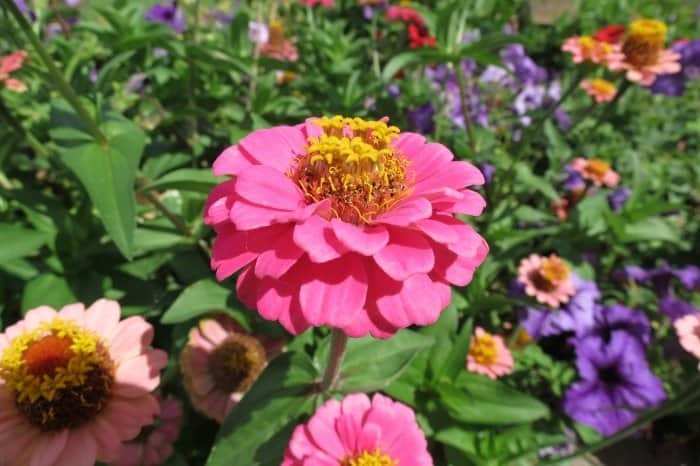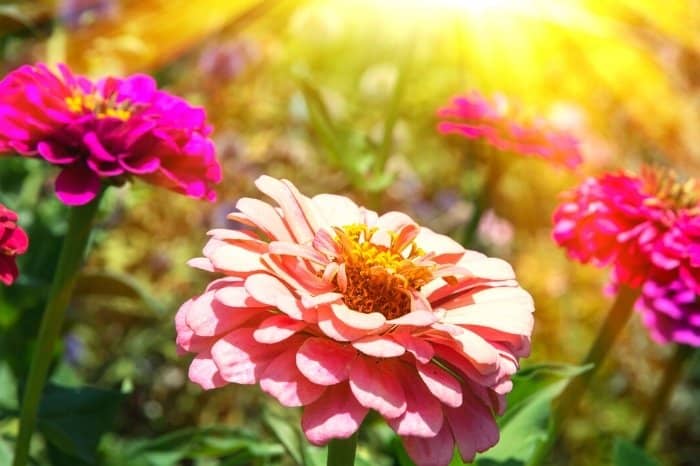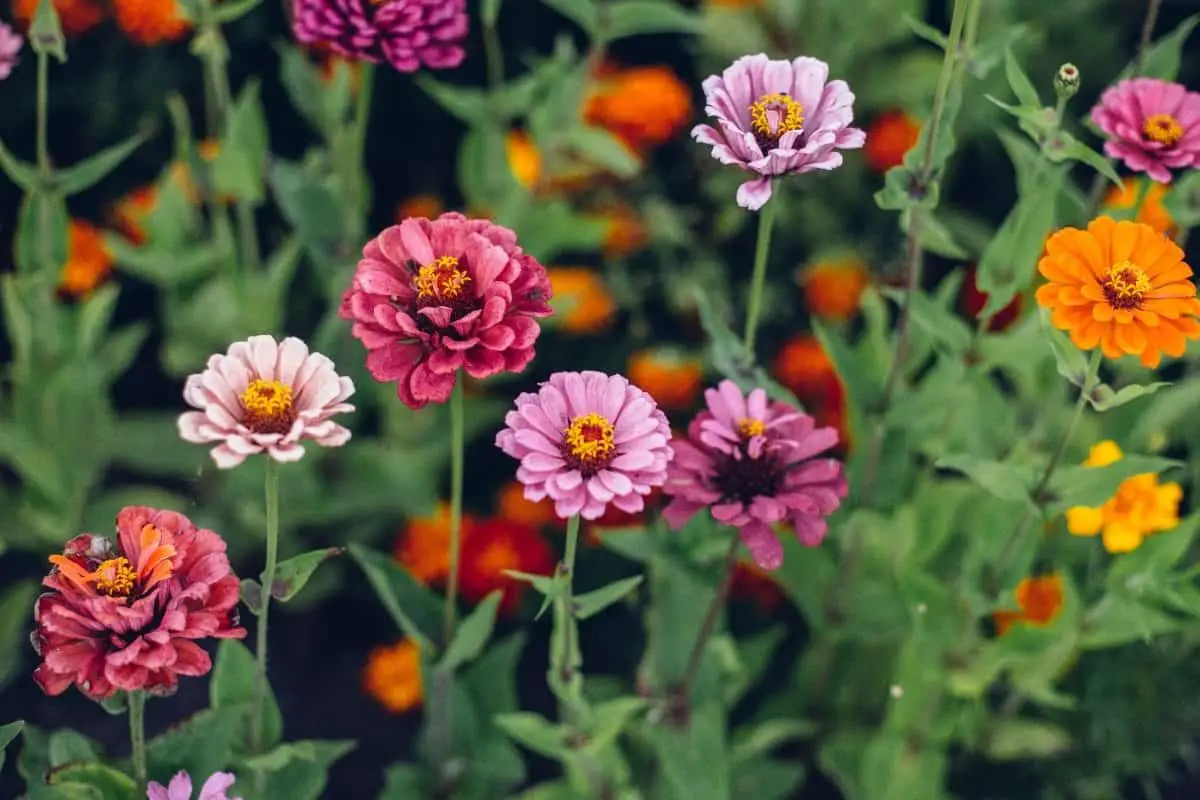Last Updated on August 14, 2021 by Cristina
Are zinnias sun or shade, or what type of climate do they thrive in? Can they grow outdoors and indoors alike?
Zinnias are a fantastic annual flower and are loved for their daisies, like shapes in vibrant colours blooming all summer to the beginning of the frost season.
If you are looking for a prolific flower for your gardens and bouquets, choose zinnias. They are as lovely in the vases sitting on your table as they are growing in the garden.
They come in a wide range of colours of the rainbow depending on their variety, and their plants range from tall about 1m to low growing.
Zinnia flowers attract bees and butterflies to your garden, so you are enhancing the environment by growing them. These flowers can be grown at the front of a border, lining a bed, or filling a pot. You can plant them alone or mix them with other flowers like cosmos to intensify the colours.
Types Of Zinnias
Zinnias are available in a variety of species, with the most popular one being Zinnia elegans. This type has been bred and produced a great number of unique varieties.
The three main types of zinnia flowers include single, semi-double, or double. The difference between these types comes from the number of petals rows and if the flower’s centre is visible.

Single–flowered zinnias have a visible centre and a single row of petals. Double-flowered zinnias have invisible centres and numerous rows of petals. Semi-double flowered zinnias have visible centres with numerous rows of petals.
Zinnia flowers also come in several shapes, including buttons, beehives, and cactus. The plants also come in different heights; the taller varieties are best for the back of the garden, while the shorter work well on the border.
Zinnias Full Sun Or Shade
Most planting directions for zinnias on the back of a plant tab or a seed packet advise that you grow your flowers under full sun.
You will need to distinguish between the full sun and part shade. If your garden receives full sun from 8 am to 8 pm or partial sun from 10 is to 4 p.m, both climates are great for zinnias to thrive.
Any garden that receives less than 6 hours of sun qualifies as part shade. The shade might be light, full, or dappled, depending on the obstruction.
The area that gets 6 hours and above is considered a full sun area. Zinnias thrive in full sun, partial sun, or partial shade. They do not love the full shade as they need the sun to bloom.
Zinnia Mix from Earth Science (2 lb), 3-in-1 Mix with Premium Wildflower Seed
Facts About Zinnias
- These beautiful flowers are native to Mexico.
- They are tender annuals and succumb very easily to frost
- You can plant either seedlings or seeds
- Planting zinnia seeds or seedlings must start at the last date of the frost date.
- This flower grows fast from germination to maturity in 8 to 12 weeks; however, it depends on the cultivar.
- If you live in the northern climates, it is advisable to start zinnias seeds indoors at least 3 to 4 weeks before the spring under bright lights.
- Zinnia seeds require plenty of light to germinate
- These flowers begin blooming in early summer
- They form new buds while the flowers bloom
- You can deadhead zinnias to keep them blooming more
- You can plant these flowers at 2 weeks intervals to enjoy a continuous bloom all summer and fall to the first day of the frost.
- These flowers enjoy full sun and tolerate drought
- They also bloom best when watered properly
Why Zinnias Love The Sun
These plants love the full sun as it helps them produce carbohydrates and sugars in their cells, known as chloroplasts. The chlorophyll in these cells gives this plant a lovely green colour. The carbohydrates enhance the process of converting nutrients for the plants to make plant tissue.

In annual plants, the growth rate is fast, and flowering is continuous, therefore the need for continuous photosynthesis. The photosynthesis supplies a reliable stream of carbohydrates resulting in plenty of bloom and more growth. This is why zinnias love lots of sun.
Zinnias Relationship With Shade
It is possible to grow zinnias in the partial sun meaning less than 6 hours of sun each day. Zinnias in the shade end up producing fewer flowers and smaller plants.
If you want to grow about 4 feet tall garden zinnias, you should aim at growing them in as much as possible.
Growing zinnias in part shade cause them to develop powdery mildew. Mildew is a fungal infection that thrives in cool, humid places with poor circulation.
Tips On How To Grow Zinnia Seeds
Zinnias are affected by insect problems – aphids, mites and fungal diseases – mildew and black spot. To prevent these problems, grow these flowers in full sun with plenty of air circulation. These flowers do not like being crowded.
Water your zinnias in the morning, so the leaves dry out quickly in the sun. If you water them in the evening, the leaves stay wet all night, making them more prone to fungal problems.
Zinnias thrive in full sun, and you can encourage more blooms by pinching back the young seedlings to make them even bushier. You want your plants to spend their energy in blooming, not growing more foliage.
These flowers grow fast and bloom in about 6 to 8 weeks after seeding. You can plant them through July for blooms that will last until the next frosting season.
Zinnias thrive in gardens, containers but not in small pots. Choose a pot that is at least 12 inches for best results.
Conclusion
Having the most colourful flower clusters is zinnias. Not only are they beautiful and bright, but they are easy for a beginner to cultivate.
Having covered zinnias sun or shade requirements, it is time to grow your own. When these flowers begin to bloom, they continue until the beginning of frost. Most people remember these plants from their grandmother’s gardens. They have been in existence for a long time, thriving in many gardens across the globe. Many gardeners have said that these flowers have that nostalgic feeling on them!
They say there is a zinnia for every garden! Plant your zinnias in an annual or mixed border garden. The smaller zinnias are best for edges, containers and window boxes.
Caroline is a gardener who loves to get down to the nitty–gritty of gardening. She proudly proclaims herself as a ‘dirt worshipper‘ and can often be found deep in the garden, covered in soil and singing to her plants. As a self–proclaimed ‘plant whisperer‘, Caroline believes that plants need love and attention just like any other living thing, and she loves to give them both. When she‘s not tending to her garden, you can often find her researching the latest gardening trends, or teaching others how to make their gardens thrive


